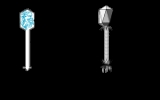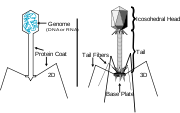
Enterobacteria phage T2
Encyclopedia

T4-like viruses
T4-like viruses are a family of bacteriophages....
genus, in the family Myoviridae
Myoviridae
The Myoviridae is a family of bacteriophages. It has been divided into three subfamiles and a number of genera not yet assigned to a subfamily. There are at least 130 species in this family.-Virology:...
. It infects Escherichia coli and is the best known of the T-even phages. Its virion
Virus
A virus is a small infectious agent that can replicate only inside the living cells of organisms. Viruses infect all types of organisms, from animals and plants to bacteria and archaea...
contains linear double-stranded DNA
DNA
Deoxyribonucleic acid is a nucleic acid that contains the genetic instructions used in the development and functioning of all known living organisms . The DNA segments that carry this genetic information are called genes, but other DNA sequences have structural purposes, or are involved in...
, terminally redundant and circularly permuted. The phage is covered by a protective protein coat, which normally contains sulfur. In addition, the only molecule in the phage that contains phosphorus is its DNA
DNA
Deoxyribonucleic acid is a nucleic acid that contains the genetic instructions used in the development and functioning of all known living organisms . The DNA segments that carry this genetic information are called genes, but other DNA sequences have structural purposes, or are involved in...
.
This phage can quickly turn an E. coli cell into a T2-producing factory that releases phages when the cell ruptures. Experiments conducted by Alfred Hershey
Alfred Hershey
Alfred Day Hershey was an American Nobel Prize-winning bacteriologist and geneticist.He was born in Owosso, Michigan and received his B.S. in chemistry at Michigan State University in 1930 and his Ph.D. in bacteriology in 1934, taking a position shortly thereafter at the Department of Bacteriology...
and Martha Chase
Martha Chase
Martha Cowles Chase , also known as Martha C. Epstein, was an American geneticist famously known for being a member of the 1952 team which experimentally showed that DNA rather than protein is the genetic material of life. She was greatly respected as a geneticist. Chase was born in 1927 in...
displayed that the DNA of viruses is injected into the bacterial cells, while most of the viral proteins remain outside. The injected DNA molecules cause the bacterial cells to produce more viral DNA and proteins. These discoveries supported that DNA, rather than proteins, is the hereditary material.
The first phages that were studied in detail included seven that commonly infect E. coli. They were named Type 1 (T1), Type 2 (T2), etc, for easy reference, but as it happens T2, T4 and T6 are structurally similar (polyhedral head, tail structure and fibres for attaching to the surface of a bacterium), and this easily recognizable shape is now referred to as the T-Even phage.
Like all viruses, T-Even phages cannot reproduce extracellularly. They need a host cell in which to replicate their genetic material. An organism which reproduces like this is called an obligate parasite, and in the case of the T-Even phages, the process ends in the cell's death.
The phage can attach to the surface of a bacterium using the proteins on its 'feet' (tail fibres), and inject its genetic material (either, but not both, DNA or RNA). This genetic material uses the host cell's ribosomes to replicate, and synthesise proteins for the capsid and tail of the phage. New phages are assembled within the cell - up to 200 - until the cellular membrane lyses (splits open). The newly made phages are now free to attack more cells. This is the Lytic cycle
Lytic cycle
The lytic cycle is one of the two cycles of viral reproduction, the other being the lysogenic cycle. The lytic cycle is typically considered the main method of viral replication, since it results in the destruction of the infected cell...
.¹

